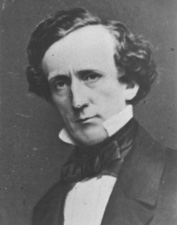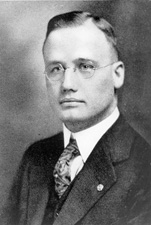|
Arthur E. Nelson
Arthur Emanuel Nelson (May 10, 1892April 11, 1955) was an American lawyer and politician who served briefly as a U.S. Senator from Minnesota during the end of 1942 and beginning of 1943 Early life and education Born in Browns Valley, Minnesota, Arthur Nelson graduated from Macalester College in 1912 and William Mitchell College of Law (then the St. Paul College of Law) in 1915. He also served briefly in the U.S. Army from August to November 1918. Political career Nelson was elected Mayor of Saint Paul, Minnesota, in 1922. He served two two-year terms. Nelson unsuccessfully ran for the United States Senate as a Republican in 1928 against Henrik Shipstead (receiving 33.4% of the vote). Senate He was elected to the Senate fourteen years later, in November 1942 to finish out the term of deceased Senator Ernest Lundeen, which had temporarily been filled by appointee Joseph H. Ball (who won the November 1942 election for the full six-year term from 1943 to 1949). Nelson ser ... [...More Info...] [...Related Items...] OR: [Wikipedia] [Google] [Baidu] |
Minnesota
Minnesota () is a state in the upper midwestern region of the United States. It is the 12th largest U.S. state in area and the 22nd most populous, with over 5.75 million residents. Minnesota is home to western prairies, now given over to intensive agriculture; deciduous forests in the southeast, now partially cleared, farmed, and settled; and the less populated North Woods, used for mining, forestry, and recreation. Roughly a third of the state is covered in forests, and it is known as the "Land of 10,000 Lakes" for having over 14,000 bodies of fresh water of at least ten acres. More than 60% of Minnesotans live in the Minneapolis–Saint Paul metropolitan area, known as the "Twin Cities", the state's main political, economic, and cultural hub. With a population of about 3.7 million, the Twin Cities is the 16th largest metropolitan area in the U.S. Other minor metropolitan and micropolitan statistical areas in the state include Duluth, Mankato, Moorhead, Rochester, and ... [...More Info...] [...Related Items...] OR: [Wikipedia] [Google] [Baidu] |
List Of United States Senators From Minnesota
Minnesota was admitted to the Union on May 11, 1858. As of January 3, 2018, the state has had 44 people serve in the United States Senate. Its current U.S. senators are Democrats Amy Klobuchar (since 2007) and Tina Smith (since 2018). The appointment of Smith marked the first time the state had two female U.S. senators at any one time. Knute Nelson is Minnesota's longest-serving senator (1895–1923). List of senators , - style="height:2em" ! rowspan=3 , 1 , rowspan=3 align=left , Henry Mower Rice , rowspan=3 , Democratic , rowspan=3 nowrap , May 11, 1858 –Mar 3, 1863 , rowspan=3 , Elected in 1858.Retired. , rowspan=3 , 1 , , 1 , Elected in 1858.Lost re-election. , nowrap , May 11, 1858 –Mar 3, 1859 , , Democratic , align=right , James Shields ! 1 , - style="height:2em" , , rowspan=3 , 2 , rowspan=3 , Elected in 1858 or 1859.Lost re-election. , rowspan=3 nowrap , Mar 4, 1859 –Mar 3, 1865 , rowspan=3 , Republican , rowspan=3 align= ... [...More Info...] [...Related Items...] OR: [Wikipedia] [Google] [Baidu] |
1955 Deaths
Events January * January 3 – José Ramón Guizado becomes president of Panama. * January 17 – , the first nuclear-powered submarine, puts to sea for the first time, from Groton, Connecticut. * January 18– 20 – Battle of Yijiangshan Islands: The Chinese Communist People's Liberation Army seizes the islands from the Republic of China (Taiwan). * January 22 – In the United States, The Pentagon announces a plan to develop intercontinental ballistic missiles (ICBMs), armed with nuclear weapons. * January 23 – The Sutton Coldfield rail crash kills 17, near Birmingham, England. * January 25 – The Presidium of the Supreme Soviet of the Soviet Union announces the end of the war between the USSR and Germany, which began during World War II in 1941. * January 28 – The United States Congress authorizes President Dwight D. Eisenhower to use force to protect Formosa from the People's Republic of China. February * February 10 – The United States Seventh Flee ... [...More Info...] [...Related Items...] OR: [Wikipedia] [Google] [Baidu] |
1892 Births
Year 189 ( CLXXXIX) was a common year starting on Wednesday (link will display the full calendar) of the Julian calendar. At the time, it was known as the Year of the Consulship of Silanus and Silanus (or, less frequently, year 942 ''Ab urbe condita''). The denomination 189 for this year has been used since the early medieval period, when the Anno Domini calendar era became the prevalent method in Europe for naming years. Events By place Roman Empire * Plague (possibly smallpox) kills as many as 2,000 people per day in Rome. Farmers are unable to harvest their crops, and food shortages bring riots in the city. China * Liu Bian succeeds Emperor Ling, as Chinese emperor of the Han Dynasty. * Dong Zhuo has Liu Bian deposed, and installs Emperor Xian as emperor. * Two thousand eunuchs in the palace are slaughtered in a violent purge in Luoyang, the capital of Han. By topic Arts and sciences * Galen publishes his ''"Treatise on the various temperaments"'' (aka ' ... [...More Info...] [...Related Items...] OR: [Wikipedia] [Google] [Baidu] |
United States Congress
The United States Congress is the legislature of the federal government of the United States. It is bicameral, composed of a lower body, the House of Representatives, and an upper body, the Senate. It meets in the U.S. Capitol in Washington, D.C. Senators and representatives are chosen through direct election, though vacancies in the Senate may be filled by a governor's appointment. Congress has 535 voting members: 100 senators and 435 representatives. The U.S. vice president has a vote in the Senate only when senators are evenly divided. The House of Representatives has six non-voting members. The sitting of a Congress is for a two-year term, at present, beginning every other January. Elections are held every even-numbered year on Election Day. The members of the House of Representatives are elected for the two-year term of a Congress. The Reapportionment Act of 1929 establishes that there be 435 representatives and the Uniform Congressional Redistricting Act requires ... [...More Info...] [...Related Items...] OR: [Wikipedia] [Google] [Baidu] |
US Congressional Delegations From Minnesota
These are tables of congressional delegations from Minnesota to the United States House of Representatives and the United States Senate. The current dean of the Minnesota delegation is Representative Betty McCollum (MN-4), having served in the House since 2001. U.S. House of Representatives Current members The House delegation has 8 members, including 4 Democrats, and 4 Republicans. List of representatives Delegates from Minnesota Territory Representatives from Minnesota 1858–1883 = 1883–1903 = = 1903–1933 = = 1933–present = United States Senate Key See also *List of United States congressional districts *Minnesota's congressional districts *Political party strength in Minnesota References {{U.S. congressional delegations Minnesota Minnesota () is a state in the upper midwestern region of the United States. It is the 12th largest U.S. state in area and the 22nd most populous, with over 5.75 million residents. Mi ... [...More Info...] [...Related Items...] OR: [Wikipedia] [Google] [Baidu] |
1942 United States Senate Special Election In Minnesota
The 1942 United States Senate special election in Minnesota took place on November 3, 1942. The election was held to fill the vacancy in the seat formerly held by the late Ernest Lundeen for the final two months of Lundeen's unexpired term. Governor Harold Stassen had appointed Joseph H. Ball to fill the seat in 1940, but this appointment was temporary and subject to a special election held in the next general election year thereafter—1942. Ball opted to run for the full six-year term immediately following the end of Lundeen's term, instead of running for election to continue for the remainder of the term. In Ball's stead, the Republican Party of Minnesota nominated Arthur E. Nelson, who, in the special election, defeated both of his challengers—Al Hansen of the Farmer–Labor Party of Minnesota and John E. O'Rourke of the Minnesota Democratic Party. Following his 1940 appointment and subsequent election, Ball ultimately served the longest tenure of any Senator only electe ... [...More Info...] [...Related Items...] OR: [Wikipedia] [Google] [Baidu] |
United States Senator
The United States Senate is the Upper house, upper chamber of the United States Congress, with the United States House of Representatives, House of Representatives being the Lower house, lower chamber. Together they compose the national Bicameralism, bicameral legislature of the United States. The composition and powers of the Senate are established by Article One of the United States Constitution. The Senate is composed of #Membership, senators, each of whom represents a single U.S. state, state in its entirety. Each of the 50 states is equally represented by two senators who serve Classes of United States senators, staggered terms of six years, for a total of 100 senators. The Vice President of the United States, vice president of the United States serves as presiding officer and president of the Senate by Ex officio member, virtue of that office, despite not being a senator, and has a vote only if the Senate is equally divided. In the vice president's absence, the Presiden ... [...More Info...] [...Related Items...] OR: [Wikipedia] [Google] [Baidu] |
Theodore Christianson
Theodore Christianson (September 12, 1883December 9, 1948) was an American politician who served as the 21st Governor of Minnesota from January 6, 1925, until January 6, 1931. Early life and education Christianson was born in Lac qui Parle Township, Minnesota. He was of Norwegian descent. He attended Dawson High School. Christianson graduated from the University of Minnesota in 1906 and the University of Minnesota Law School in 1909. He was admitted to the Minnesota State Bar in 1909. Career Before entering politics, Christianson had pursued dual careers in western Minnesota, where he both practiced law and was editor and publisher of the ''Dawson Sentinel'' for fifteen years. He served as a member of the Minnesota House of Representatives for five terms. "More Ted, Less Taxes" was the Christians's campaign slogan when he ran for governor in 1924. During his administration, he limited taxes and cut expenditures at every level of state government. He was re-elected twice. Dur ... [...More Info...] [...Related Items...] OR: [Wikipedia] [Google] [Baidu] |
1936 Minnesota Lieutenant Gubernatorial Election ...
The 1936 Minnesota lieutenant gubernatorial election took place on November 3, 1936. Minnesota Farmer–Labor Party candidate Gottfrid Lindsten defeated Republican Party of Minnesota challenger Arthur E. Nelson and Minnesota Democratic Party candidate A. C. Knudson. Results External links Election Returns Lieutenant Gubernatorial 1936 {{Minnesota-election-stub Minnesota Minnesota () is a state in the upper midwestern region of the United States. It is the 12th largest U.S. state in area and the 22nd most populous, with over 5.75 million residents. Minnesota is home to western prairies, now given over to ... [...More Info...] [...Related Items...] OR: [Wikipedia] [Google] [Baidu] |
Lieutenant Governor Of Minnesota
The lieutenant governor of Minnesota is a constitutional officer in the executive branch of the U.S. State of Minnesota. Fifty individuals have held the office of lieutenant governor since statehood. The incumbent is Peggy Flanagan, a DFLer and the first Native American elected to a statewide executive office in Minnesota's history. Powers and duties The lieutenant governor assists the governor in carrying out the functions of the executive branch, as well as serving in the governor’s place in the event of his or her absence or disability. The governor, as prescribed by law, may file a written order with the secretary of state to delegate to the lieutenant governor any powers, duties, responsibilities, or functions otherwise performed by the governor. As a key member of the governor's cabinet, the lieutenant governor is consulted on all major policy and budgetary decisions. Moreover, the lieutenant governor is a statutory memb ... [...More Info...] [...Related Items...] OR: [Wikipedia] [Google] [Baidu] |






